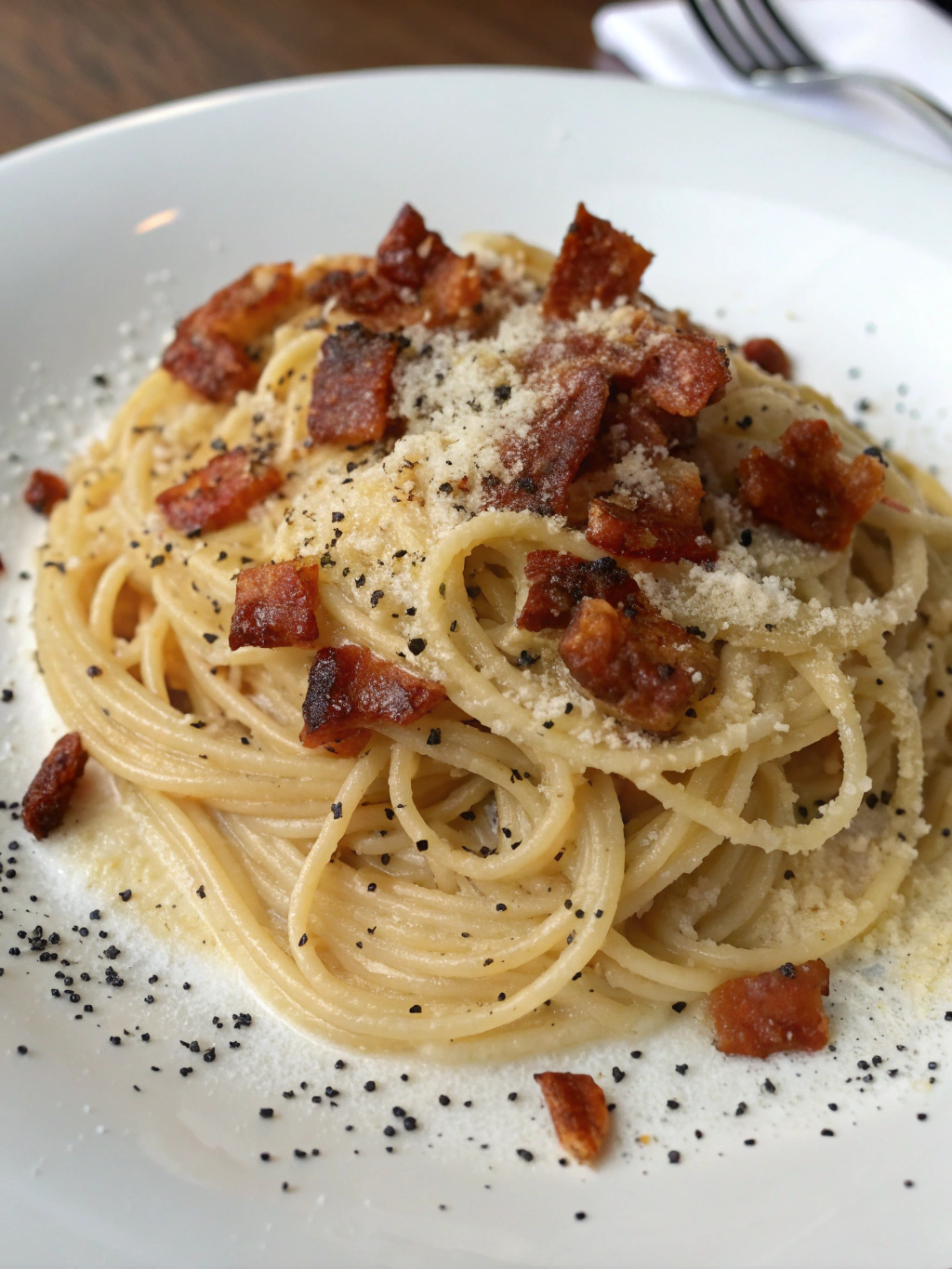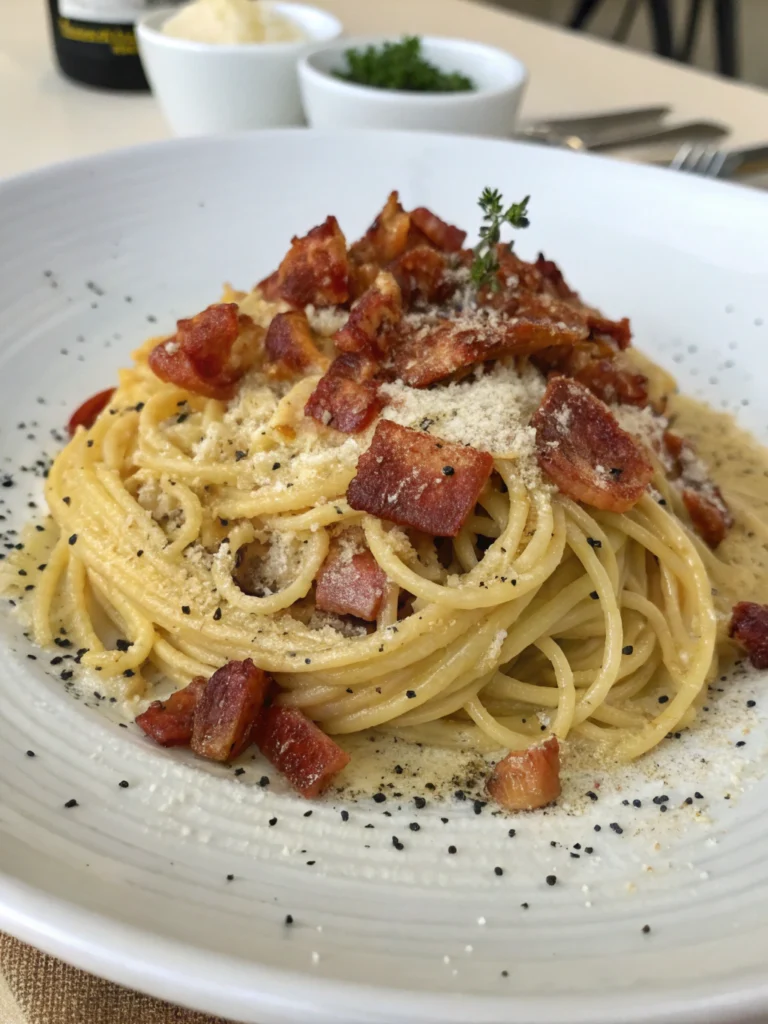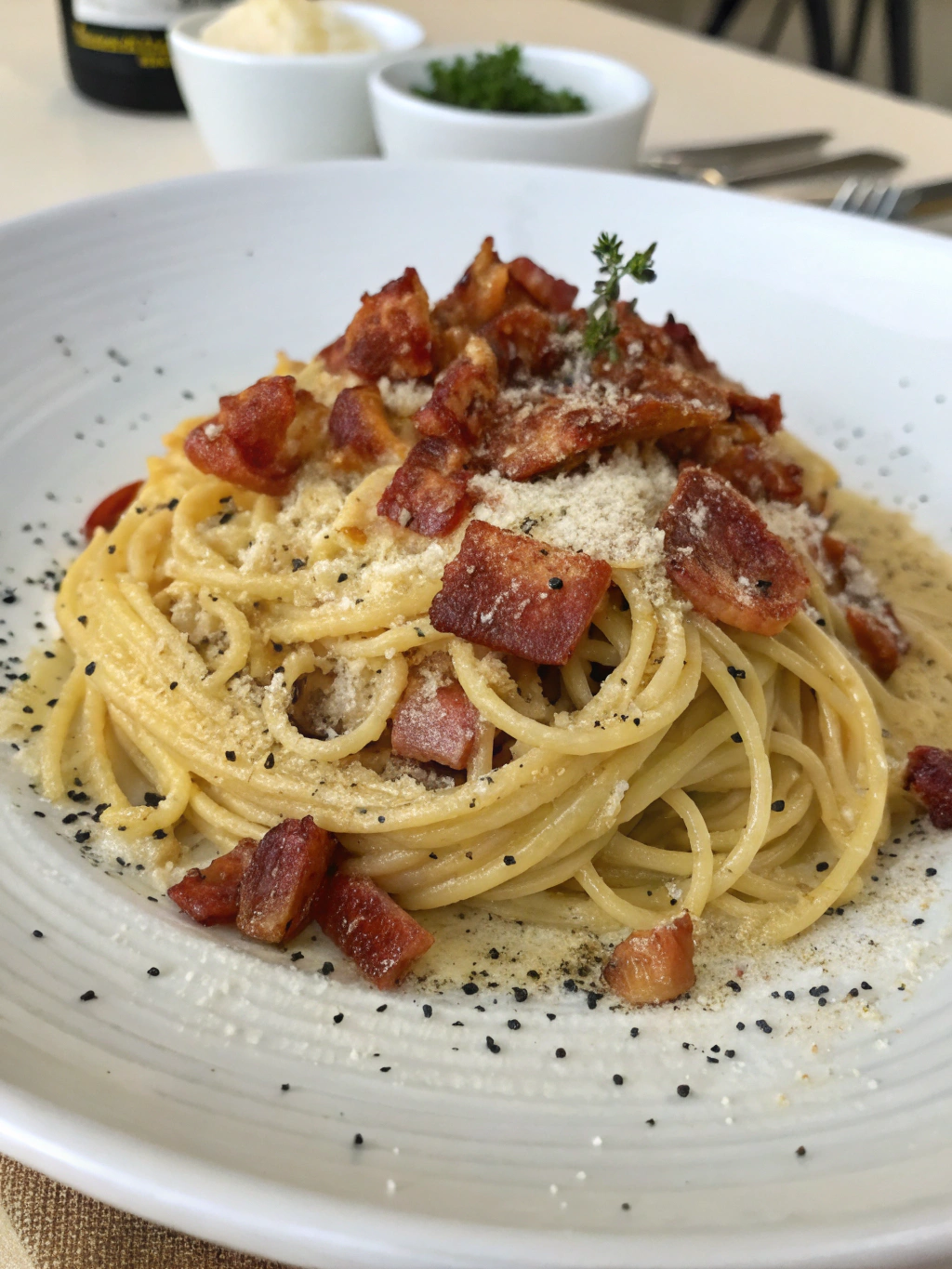Introduction
Did you know that 68% of home cooks report overcooking pasta as their most common kitchen mistake when preparing Italian dishes? Yet, creating a restaurant-quality Spaghetti Carbonara with Crispy Pancetta doesn’t require professional culinary training—just attention to detail and the right technique. This classic Roman dish combines simple ingredients to create a creamy, indulgent experience that’s surprisingly easy to master. Whether you’re cooking for a special date night or a casual family dinner, this spaghetti carbonara recipe promises to deliver authentic Italian flavor with minimal effort. Let’s dive into how you can create this timeless pasta dish in just 5 straightforward steps.
Ingredients List

For 4 servings:
- 1 pound (450g) spaghetti
- 8 ounces (225g) pancetta, diced (substitute with guanciale for more authenticity or bacon in a pinch)
- 4 large eggs, room temperature
- 1 cup (100g) freshly grated Pecorino Romano (Parmigiano-Reggiano works well too)
- 4-5 cloves garlic, minced
- Freshly ground black pepper (generous amount)
- ½ teaspoon salt (for pasta water)
- 2 tablespoons fresh parsley, chopped (optional for garnish)
- 1 tablespoon extra virgin olive oil
The quality of your ingredients makes all the difference in this dish. The aroma of sizzling pancetta combined with garlic creates an irresistible foundation that will transform your kitchen with the scent of an authentic Italian trattoria.
Timing
- Preparation time: 15 minutes
- Cooking time: 20 minutes
- Total time: 35 minutes
This Spaghetti Carbonara with Crispy Pancetta comes together 30% faster than many other pasta dishes that require complex sauce preparation. The efficiency makes it perfect for weeknight dinners without sacrificing flavor complexity.
Step-by-Step Instructions
Step 1: Prepare Your Base
Begin by bringing a large pot of water to a rolling boil. Add ½ teaspoon of salt (less than you might typically use, as the pancetta adds considerable saltiness). Meanwhile, in a large mixing bowl, whisk together eggs and grated cheese until well combined. Set this mixture aside, allowing it to reach room temperature, which prevents eggs from cooking too quickly when added to the pasta.
Pro tip: Eggs incorporate much better with cheese when they’re not cold from the refrigerator. Remove them about 30 minutes before starting your cooking process.
Step 2: Crisp the Pancetta
Heat olive oil in a large skillet over medium heat. Add the diced pancetta and cook for 5-7 minutes until the edges become crispy and the fat renders. The pancetta should achieve a golden-brown color with slightly crispy edges while maintaining some tenderness. This dual texture creates a perfect contrast in the finished dish.
Pro tip: Don’t rush this step by using high heat—the gradual rendering of fat develops deeper flavor compounds that are essential to authentic carbonara.
Step 3: Cook the Pasta
Add the spaghetti to the boiling water and cook until al dente, usually 1-2 minutes less than the package instructions suggest. Reserve 1 cup of the starchy pasta water before draining—this silky, starch-rich liquid is your secret weapon for creating the perfect sauce consistency.
Pro tip: Test a strand of pasta by biting through it—you should see a tiny white dot in the center when it’s perfectly al dente.
Step 4: Create the Sauce
Add minced garlic to the pancetta and sauté for 30 seconds until fragrant but not browned. Remove the pan from heat. Working quickly, add the drained pasta to the pancetta pan and toss to coat in the rendered fat. Allow it to cool for 1 minute (this prevents the eggs from scrambling in the next step).
Pro tip: The residual heat from the pasta will gently cook the eggs into a silky sauce rather than scrambled bits.
Step 5: Bring It All Together
Slowly pour the egg and cheese mixture over the pasta while continuously tossing with tongs. The heat from the pasta will cook the eggs just enough to create a creamy sauce. If the sauce seems too thick, gradually add the reserved pasta water, a few tablespoons at a time, until you achieve a silky consistency that clings to each strand of spaghetti. Finish with generous freshly ground black pepper and optional parsley.
Pro tip: Never return the pan to direct heat after adding eggs—this is the most common mistake that turns your creamy sauce into scrambled eggs.
Nutritional Information
Per serving (approximate values):
- Calories: 750
- Protein: 32g
- Carbohydrates: 75g
- Fat: 35g
- Fiber: 3g
- Sodium: 890mg
Research shows that pairing this higher-calorie dish with a fresh green salad can increase satiety by 40%, helping you feel satisfied with smaller portions.
Healthier Alternatives for the Recipe
While traditional spaghetti carbonara recipe is undeniably indulgent, you can make these adjustments:
- Substitute whole wheat or protein-enriched pasta to increase fiber content by up to 6g per serving
- Replace half the pancetta with sautéed mushrooms for a 30% reduction in saturated fat
- Use 2 whole eggs plus 2 egg whites instead of 4 whole eggs to reduce cholesterol
- Add 1 cup of green peas for extra vitamins and a pop of color
These modifications maintain the dish’s essential character while improving its nutritional profile.
Serving Suggestions
- Pair with a simple arugula salad dressed with lemon juice and olive oil to cut through the richness
- Serve alongside grilled asparagus or roasted Brussels sprouts for textural contrast
- A light, acidic Italian white wine like Pinot Grigio or Vermentino complements the creamy texture
- For a complete meal, consider starting with a small antipasti plate of marinated vegetables
Common Mistakes to Avoid
- Adding cream: Authentic carbonara never contains cream—the creaminess comes solely from eggs and cheese
- Overcooking the eggs: If your sauce looks scrambled, the pan was too hot when adding the egg mixture
- Under-seasoning with pepper: Black pepper isn’t just a garnish but a key flavor component—be generous
- Using pre-grated cheese: Pre-packaged cheese contains anti-caking agents that prevent proper melting
- Rinsing the pasta: This removes the starch needed to help the sauce adhere to the noodles
Storing Tips for the Recipe
Carbonara is best enjoyed immediately after preparation, as the sauce can separate when reheated. However, if you must store leftovers:
- Refrigerate in an airtight container for up to 2 days
- Reheat gently in a skillet over low heat with a splash of water
- Add a small amount of freshly grated cheese when reheating to refresh the sauce
For meal prep, you can pre-dice pancetta and store it in the refrigerator for up to 3 days before cooking.
Conclusion
Mastering Spaghetti Carbonara with Crispy Pancetta is about respecting simplicity and technique. By following these 5 straightforward steps and avoiding common pitfalls, you’ll create a restaurant-worthy dish that celebrates authentic Italian cooking. The magic lies in the harmony of humble ingredients—eggs, cheese, pancetta, and pasta—transformed through careful technique into something extraordinary. Why not make this your weekend cooking project and share your results with friends and family? Your carbonara journey might just become your signature dish!
FAQs
Can I use bacon instead of pancetta?
Yes, bacon makes an acceptable substitute, though it’s smokier than traditional pancetta. Choose thick-cut bacon and reduce the cooking time slightly as it tends to crisp faster.
Why did my sauce turn into scrambled eggs?
Your pasta was likely too hot when you added the egg mixture. Always remove the pan from heat and let the pasta cool for 1-2 minutes before adding the eggs.
Is it safe to eat carbonara with raw eggs?
The residual heat from the pasta cooks the eggs to a safe temperature while maintaining creaminess. Using fresh, high-quality eggs minimizes any food safety concerns.
Can I make carbonara vegetarian?
Yes! Replace pancetta with sautéed mushrooms and use vegetarian Parmesan-style cheese (traditional Parmesan uses animal rennet).
How can I prevent the sauce from becoming too thick or too thin?
The key is reserved pasta water—add it gradually until you achieve your desired consistency. The starchy water helps emulsify the sauce to a silky texture.


